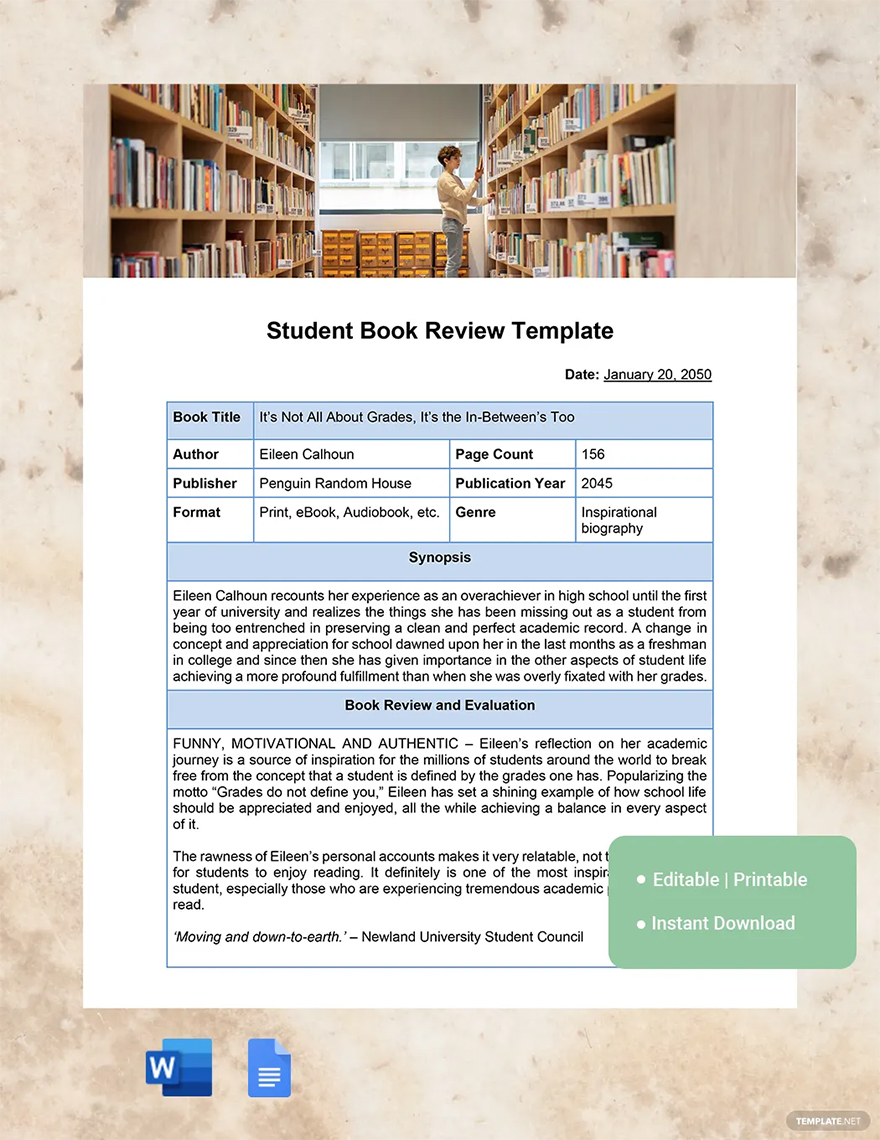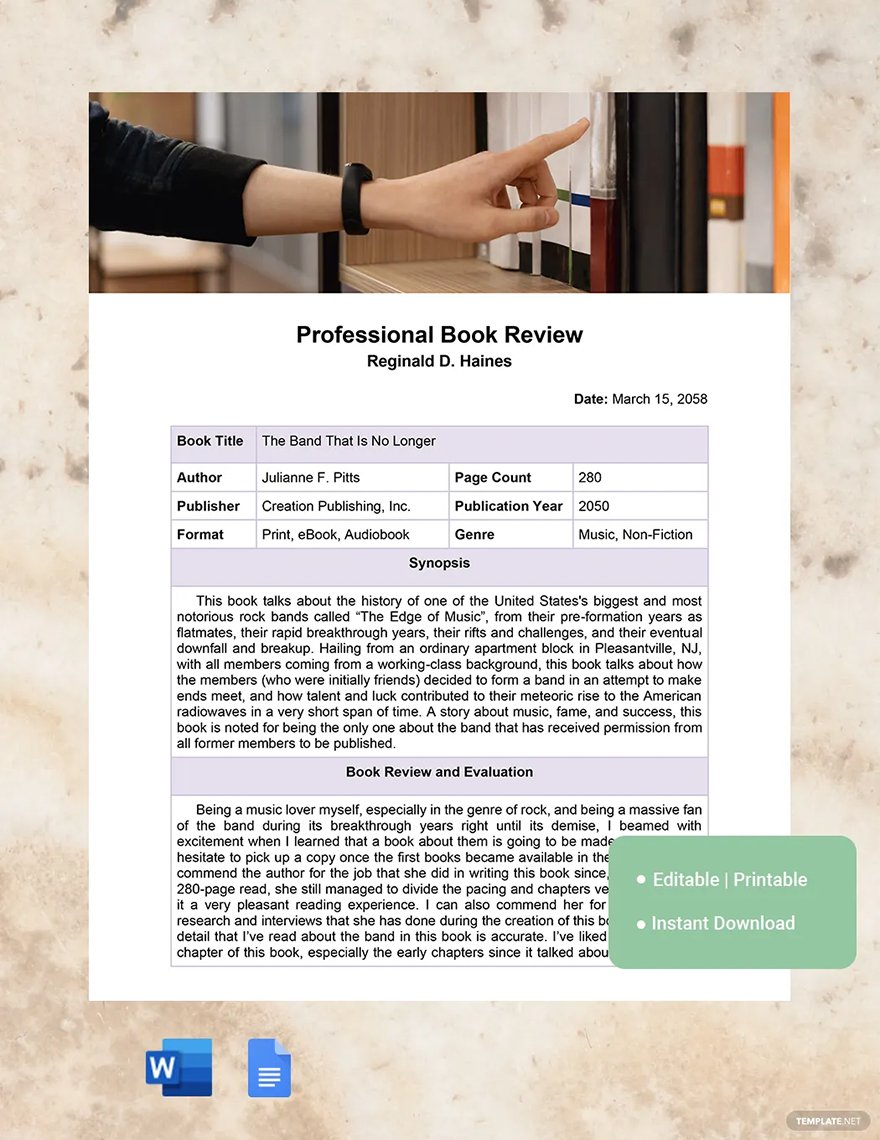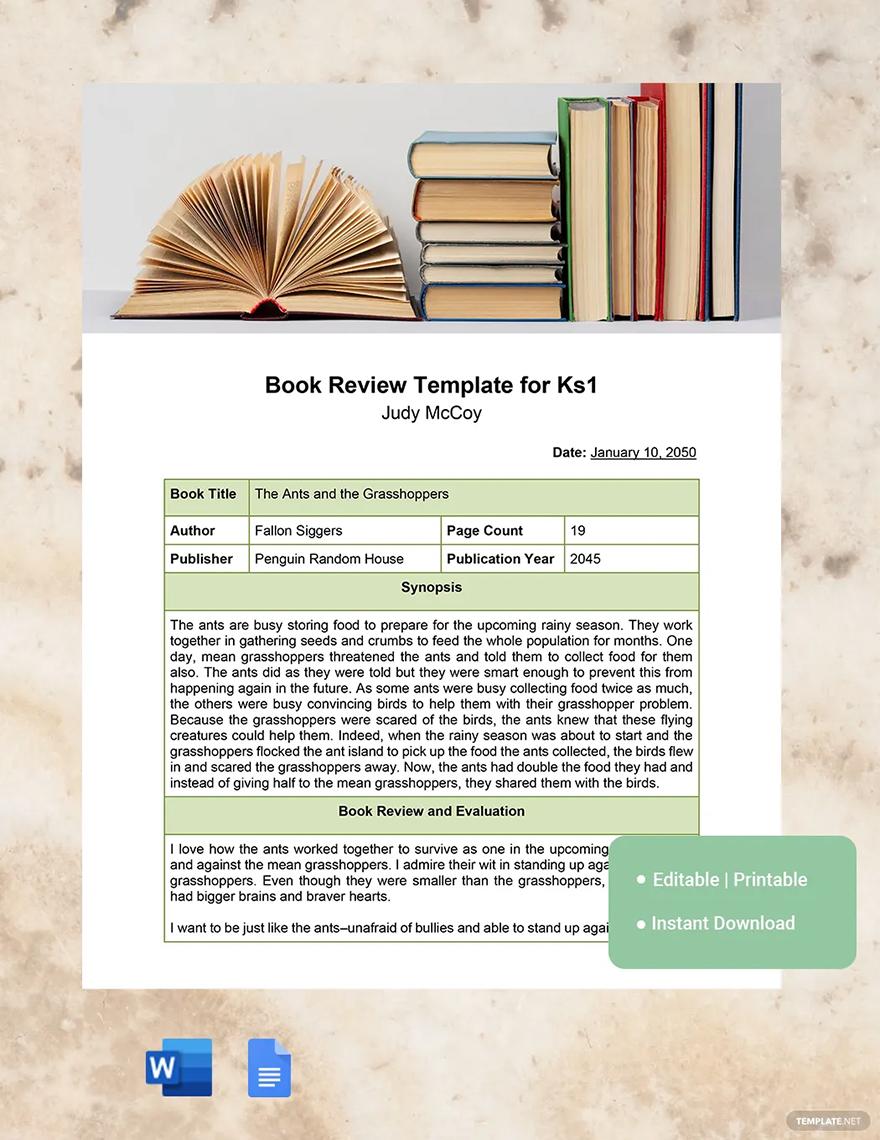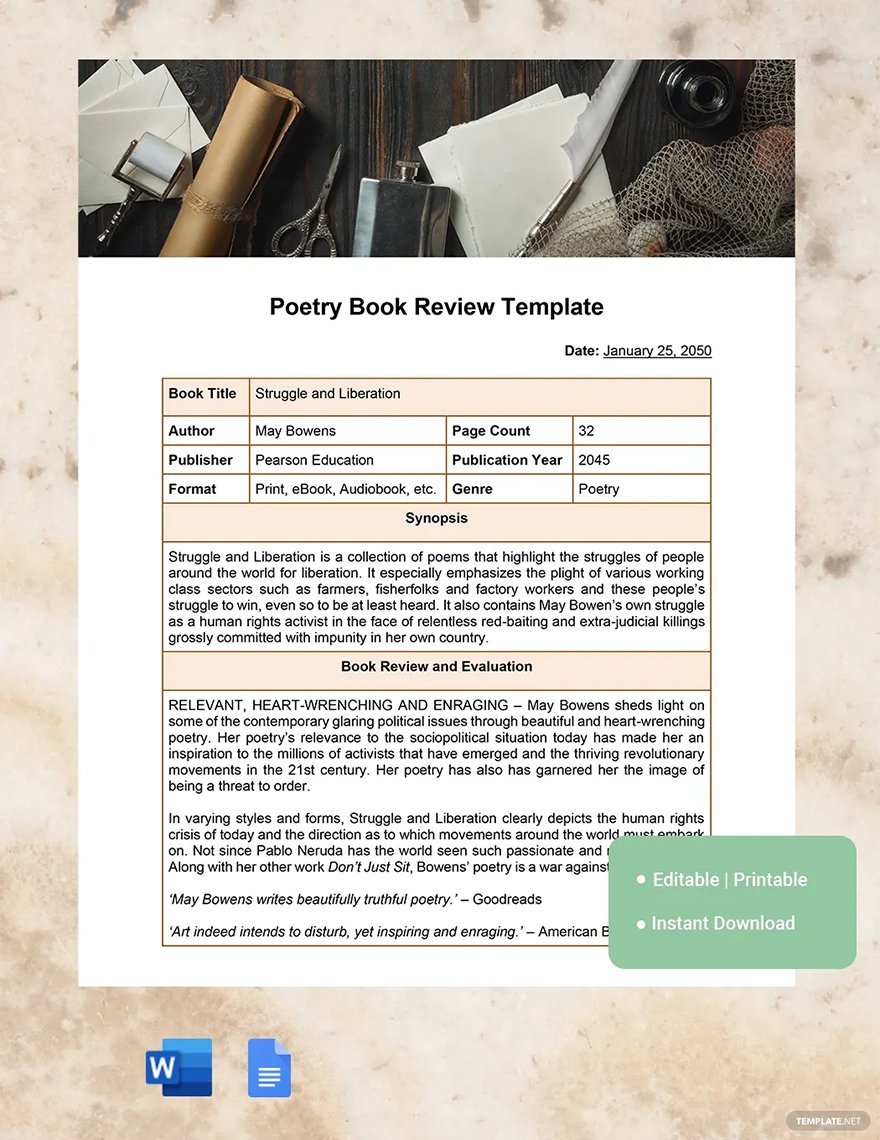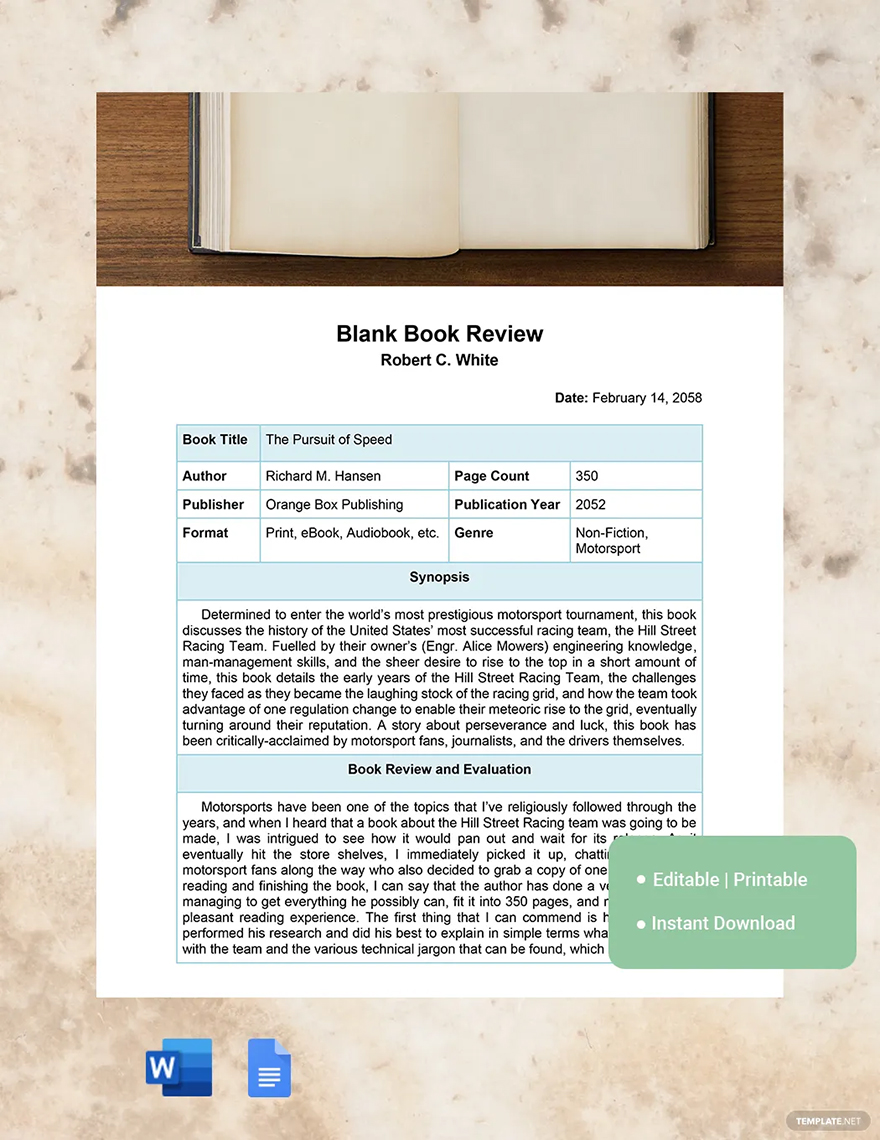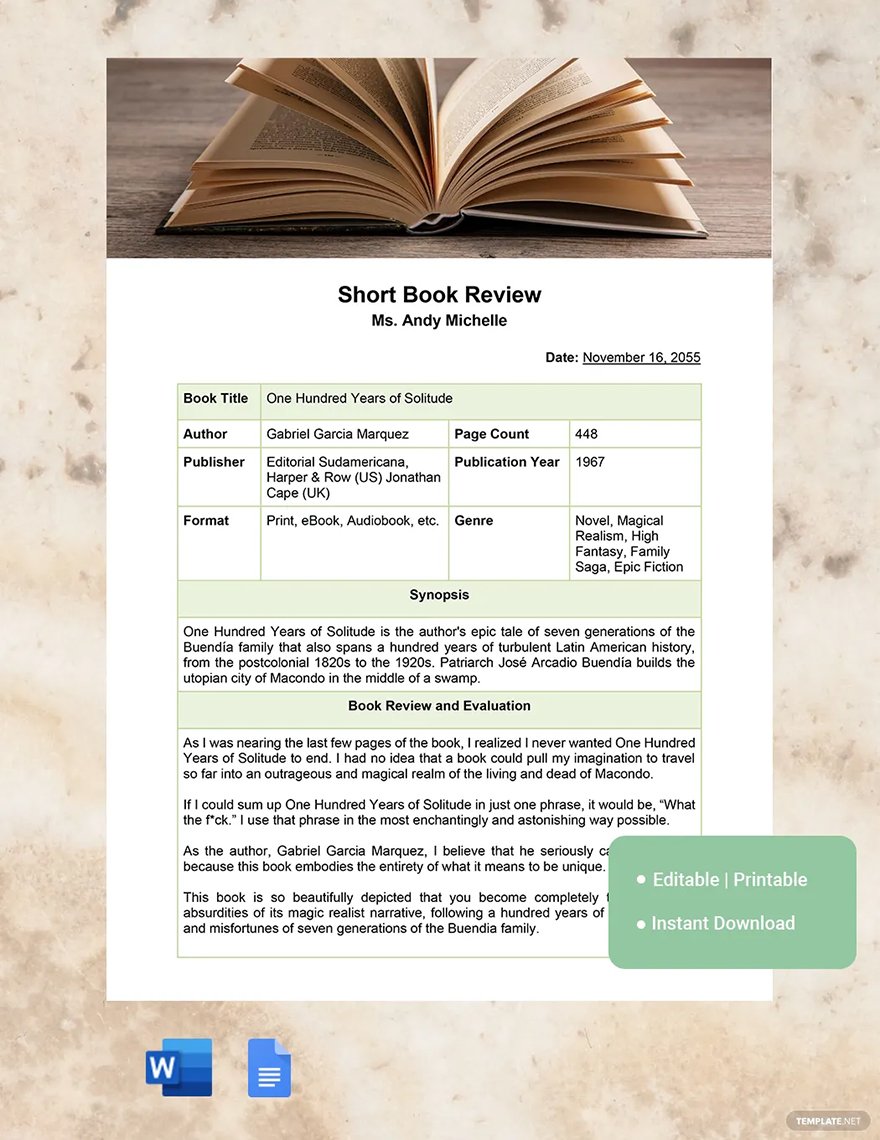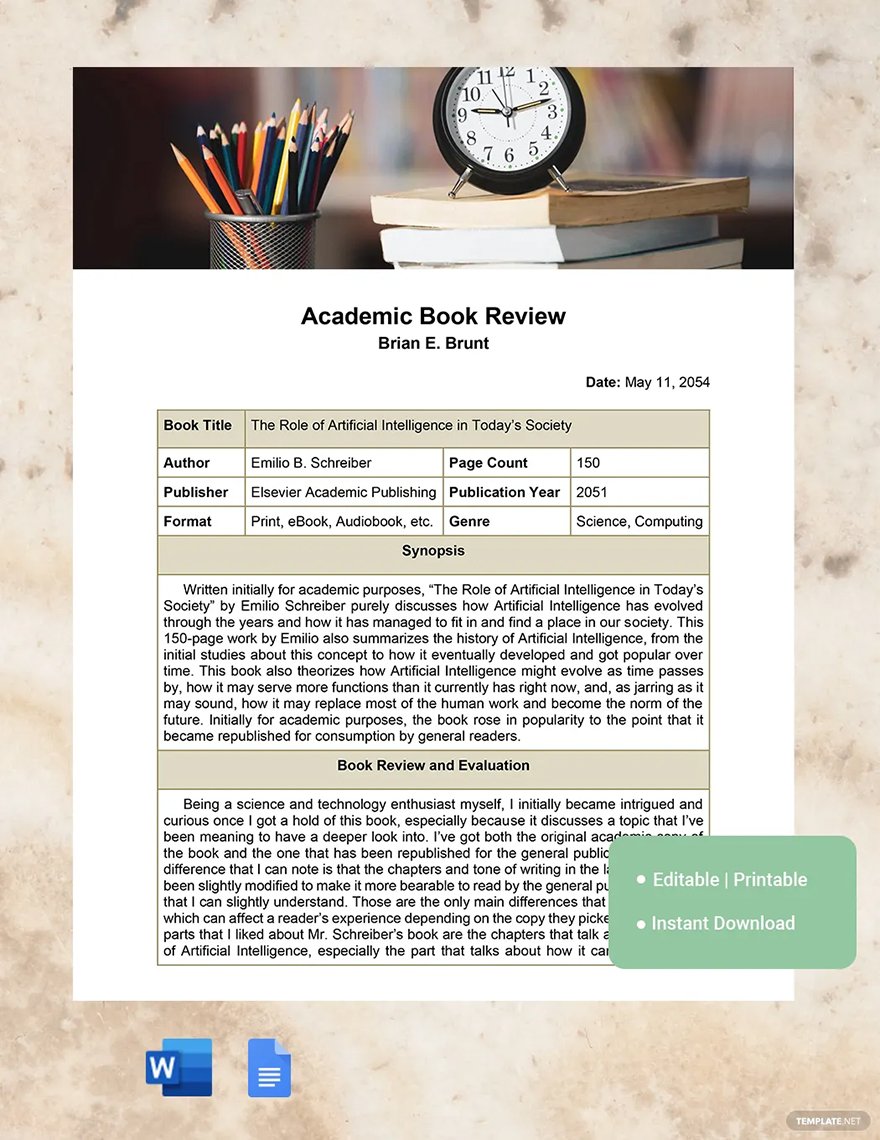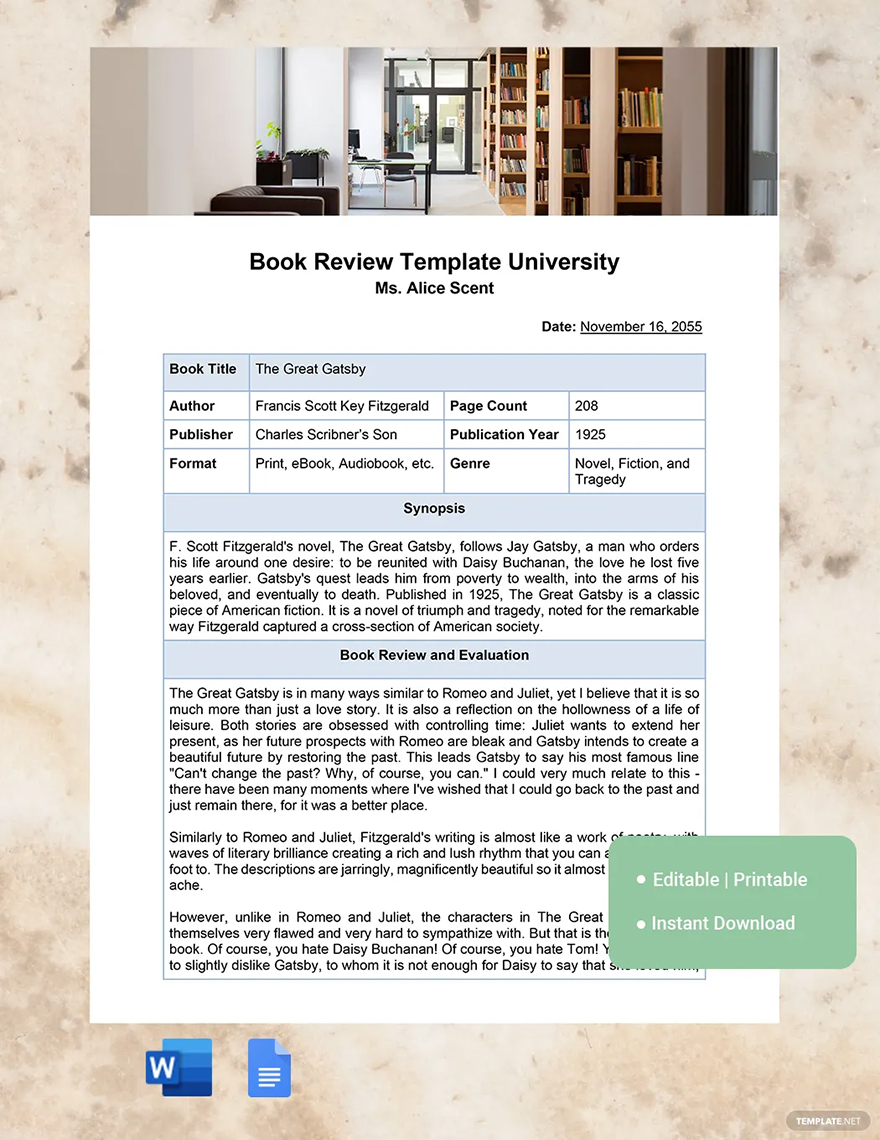Book Review
Book reviews are documents that people see in different fields, including educational institutions and professional roles in an industry or organization, centering on providing feedback. Use book reviews to help middle school kids to college students construct proper formats for their next activity or project in literature, writing according to APA styles.

Book Review Definition & Meaning
A book review is an evaluation document that contains information about newly released books with a brief description of the book’s main ideas, like its theme and characters.
A book review also contains a short outline of the strengths and weaknesses of the book for a thorough evaluation coming from the reviewer to the author.
What Is a Book Review?
A book review contains a critical analysis of a book, including a narrative synopsis, information on the main characters and principal ideas, and a positive or negative assessment of the author’s style of writing. The content helps readers decide whether to grab a book or skip it by offering readers various perspectives on the book’s advantages and drawbacks of reading it. Book reviews are written by qualified experts who work for magazines, review websites, scholarly journals, and literature review publications.
10 Types of Book Reviews
Fiction Book Review
A fiction book review focuses on writing a critical analysis of newly released or reworked fiction books, including novels, short stories, legends, and fairy tales. These contain information about the book’s main characters, significant plot points, and locations, inserting details about facts or events. The review also contains strengths and weaknesses of the plot and theme and the author’s writing style.
Student Book Review
Student book reviews enable students to write their own opinion regarding the author’s ideas, usually working with worksheets containing questions. Book reviews are a form of literary criticism analyzing an author’s ideas, writing techniques, and work quality. The analysis is opinion-based and relevant to the book’s contents, making it a practice for students who want to become editors.
Professional Book Review
Experts and critics construct professional book reviews working for credible institutions, such as newspapers, magazines, blogs, online publications, and paid services agencies, providing high-grade reviews. Reviewers have a solid background in the craft of book writing, landing them on the front pages of many news outlets. Many booksellers rely on professional book reviews when making recommendations.
Ks1 Book Review
The Ks1 book review worksheet is ideal for Ks1 students learning to write book reviews since it has prompts for each main section. Each component of a Ks1 book review includes questions that push students to think critically about what they read. The book review should concentrate on the plot, characters, students’ opinions, and whether or not they would suggest the book, incentivizing their viewpoints.
Poetry Book Review
A poetry book review focuses on writing a critical analysis regarding a collection of poetry from a single poet or a group of poets. The review focuses on the genre of the collection of poems and how the authors express their feelings or emotions through each verse. People writing a poetry book review must have a graphic organizer or chart to distinguish relevant ideas, especially if there are several points of view.
Blank Book Review
A blank book review allows reviewers to construct a critical analysis of a book, specifying the book’s general information, subject, and theme. A blank book review serves as a template for reviewers, acting as a guide for new reviewers in creating an unbiased review. It also serves as a way for individuals to practice their analysis and critical thinking skills, using the blank book review to work on other genres.
Short Book Review
A short book review is common in blogs and online review portals, evaluating books and authors, writing a brief description, and a short analysis. A short book review talks about the essential information that helps readers to determine whether or not they would like the book based on the reviewer’s comments. Ensure that it also contains unbiased opinions about the strengths and weaknesses of the author’s effectiveness in delivering the message.
Academic Book Review
Scholarly book reviews or academic book reviews are common in scholarly journals and are produced by academic scholars. These book reviews serve several functions, but they typically educate other academics about the quality and objectives while describing how the book fits into the literature. Reviews are vital and useful documents to help other scholars decide whether or not to read or buy the book.
University Book Review
University book reviews are coursework, assignments, or projects that university students receive from their professors, focusing on a specific text and writing their evaluation about its content. The document must contain an introduction that details the author’s name, book title, genre, and characters. Writing a thorough analysis to identify the main ideas is also vital, ending with an overall evaluation of the book’s quality.
Simple Book Review
A simple book review talks about a specific book, detailing the book’s main idea, characters, and genre. The book review reflects the individual’s capacity to read and understand a book’s contents while evaluating the arguments and issues raised by the author. Writing the book review shows similarities in making an essay, presenting evidence, and writing all the information in a clear and structured manner.
Book Review Uses, Purpose, Importance
Book reviews are vital documents for many readers and authors as it contains an explanation, evaluation, and analysis of the book’s essence. The book review is neither a summary nor a report; it focuses on a book’s structure, writing style, and the purpose of the book’s message. As book reviews hold a heavy toll on readers and authors, it is necessary to know the uses and importance of the document to both parties.
Understand the Readers’ Desires
Authors learn a lot about their writing by reading the reviews published about their books. Additionally, it provides insight serving as a learning opportunity for writers, significantly helping them in their future writing endeavors. Book reviews also identify mistakes, like a chapter being confusing and difficult to understand, letting the author communicate with readers to guarantee their satisfaction.
Increase Book Sales
Publishers use numerous marketing strategies to increase sales of specific books by hiring book reviewers to compose quality reviews. A review also helps increase sales, building up an author’s credibility, especially when readers inquire about a book’s contents to make purchasing decisions. Reviews also help with search engine optimization or SEO as reviewers use keywords relevant to books, including the book title, author’s name, and genre; the more these keywords are visible in reviews, the more chances it appears on search rankings.
Engage with Readers
Book reviews enable audiences to talk about their perspective on a book, with a majority of written reviews helping authors and other readers understand the work and help them make purchasing decisions. Positive reviews recommend a writer’s piece to others and serve as an integral part of a marketing strategy, promoting a book to others more than a book’s summary or description. Reviews play a pivotal role in acquiring reader engagement as an author and help connect and promote their life’s work.
Improve Writing Skills
It is beneficial for writers to acquire market feedback as it helps them in their writing process, allowing room for growth as an established author. Constructive criticism gives writers a different perspective on their writing and lets them know their strengths and weaknesses. Authors also need to accept feedback as a learning process to improve their skills, with writers being consistent with a constructive approach and pointing out things that are hardly noticeable by themselves.
Build an Author’s Brand
Brand building helps authors target a specific market interested in their genre, building feelings of trust for new readers, and converting them into fans. Book reviews help build a brand by expressing thoughts about a book, including its characters, proficiency, and genre, as well as knowing the author’s writing preferences to target prospective readers. The more book reviews express things that make up an author’s brand equate to more people having confidence in an author’s writing prowess.
What’s In A Book Review? Parts?
Introduction
The introduction section of the book review consists of general information about the author’s name, book title, main theme, additional details about the author, including their field or genre, book context, book thesis, and the reviewer’s thesis.
Content Summary
The summary of the content must be brief, backing up declarations with concrete details and evidence from the book with the tone and delivery of the content matching the intended audience of the book review.
Book Analysis and Evaluation
The book analysis and evaluation must be in orderly paragraphs dealing with specific ideas and subjects of the book to make it easier for the reviewer to differentiate the different elements of statements and criticisms with necessary pieces of information.
Conclusion
For the conclusion portion of the book report, the reviewer summarizes and restates their thesis to make a final review of the book, balancing the strengths and weaknesses of the book to unify the reviewer’s evaluation and impact of the book review to its audience.
How to Design a Book Review
1. Determine the Book Review Size
2. Specify the Purpose of Creating the Book Review
3. Select from the Book Review Templates
4. Construct a Brief Summary
5. Deliver a Thorough and Balanced Evaluation
6. Provide an Unbiased Recommendation
Book Review vs. Summary
Book reviews are generally evaluative and interactive, detailing what a book is about, writing commentaries and assessments about the book through critical feedback, and detailing strengths and weaknesses.
Meanwhile, a summary contains a brief restatement of a book’s contents, usually less than ten pages long, with chapters and sections representing one paragraph.
What’s the Difference Between a Book Review, Essay, & Review?
A book review contains information that seeks to evaluate the contents of a book, including its genre, characters, and the author’s writing style, composing a critical analysis of the book’s entirety.
The essence of an essay is to prove an argument or a person’s perspective regarding a specific topic, using topics and ideas that are relevant to the discussion.
A review, in general, is a critical evaluation of various texts, things, events, or phenomena containing an argumentative commentary about a topic or subject with a reviewer clearly stating their opinion.
Book Review Sizes
A book review features constructive feedback about a book, including information about its theme, writing style, and characters, to employ honest criticism about an author’s work. Many professional book reviewers write their feedback on a letter, legal, or A4 paper as standard book review sizes in PDF for online submissions as attachments.
- Letter (8.5 x 11 inches)
- Legal (8.5 x 14 inches)
- A4 (8.3 × 11.7 inches)
Book Review Ideas & Examples
People use book reviews for various reasons, including writing book review reports or projects following school formats and layouts to fulfill requirements. Aside from that, other book review ideas are appropriate for different age groups, like reviewing children’s books or scholarly articles.
- Book Review For Ks2 Ideas and Examples
- Non Fiction Book Review Ideas and Examples
- Basic Book Review Ideas and Examples
- Book Review Ks3 Ideas and Examples
- Book Review For Kids Ideas and Examples
FAQs
What must a book review include?
A book review must have an introduction, content summary, book evaluation and analysis, and conclusion.
What are the three elements of a book review?
The three elements of a book review are the introduction, the body, and the conclusion.
What makes a good book review?
A good book review must have balance, talk about the book, specify the author’s work, have a concise summary, don’t contain spoilers, and be specific.
What are the phases of writing a book review?
The phases of writing a book review include writing the introduction, outlining content, highlighting its parts through chapters and themes, and providing a detailed evaluation.
What is the aim of a book review?
The purpose of a book review is to help readers and other people decide whether or not they want to read a specific book.
How does the book review begin?
The first few sentences of a book review start with an introduction to the topic of a book.
Is a book review the same as a summary?
A book review details the content of a narrative in all aspects, while a summary is only a short version of the book’s contents.
What do you understand by book review?
Book reviews are documents detailing a book’s description, analysis, and evaluation in terms of quality, meaning, and purpose.
What are the criteria for reviewing a book?
When writing a book review, consider asking how the characters influence the story, how the title applies to the entire story, what themes and subjects stand out, what are the main ideas in the book, and what quotes stand out the most.
What are the two guidelines for writing a book review?
Identify a book’s main ideas and themes and define its strengths and weaknesses through descriptive or critical reviews.






